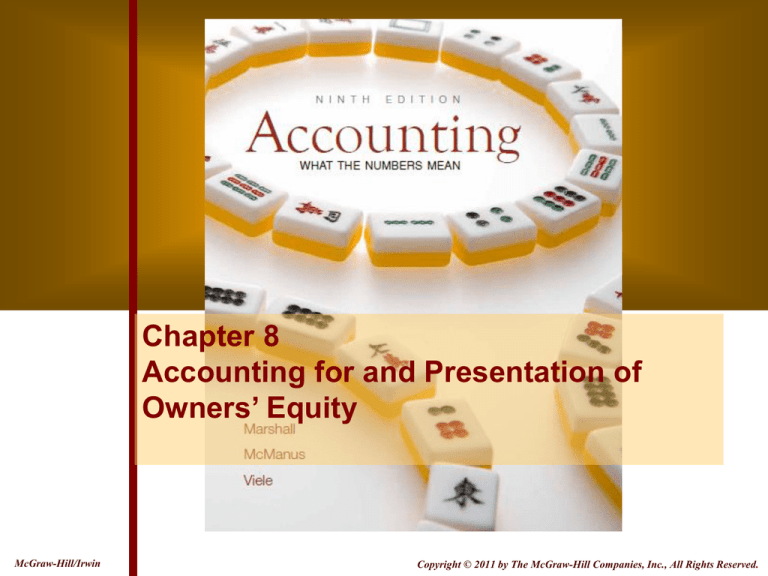
1-1
8-1
© 2008 The McGraw-Hill Companies, Inc., All Rights Reserved.
Chapter 8
Accounting for and Presentation of
Owners’ Equity
McGraw-Hill/Irwin
McGraw-Hill/Irwin
8-1
© 2008
The©McGraw-Hill
Companies,
Inc., All
Reserved.
Copyright
2011 by The McGraw-Hill
Companies,
Inc.,Rights
All Rights
Reserved.
1-2
8-2
LO 1
Owners’ Equity Section
Owners' Equity
Paid-in capital
Common stock $1 par, 100,000 shares
issued and 95,000 outstanding
Additional paid-in capital
Total paid-in capital
Retained earnings
Total paid-in capital and retained earnings
Less: cost of treasury stock (5,000 shares)
Total owners' equity
McGraw-Hill/Irwin
$
100,000
2,800,000
2,900,000
1,400,000
4,300,000
(150,000)
$ 4,150,000
8-2
© 2008 The McGraw-Hill Companies, Inc., All Rights Reserved.
1-3
8-3
Paid-in Capital
LO 1
Common Stock
On January 1, 2010, Matrix, Inc. issued 100,000 of its $3 par value
common stock for $14 per share. The following entry is recorded:
GENERAL JOURNAL
Date
Account Titles and Explanation
2010
Jan. 1 Cash
Common stock
Additional-paid-in-capital
Debit
Credit
1,400,000
300,000
1,100,000
This transaction has the following effect on the financial statements of
Matrix:
Balance Sheet
Assets
=
Cash
+1,400,000
McGraw-Hill/Irwin
Liabilities
Income Statement
+
Owners'
Equity
Common
Stock
+300,000
Additional
Paid-in
Capital
+1,100,000
Net
income
=
Revenues
-
Expenses
8-3
© 2008 The McGraw-Hill Companies, Inc., All Rights Reserved.
1-4
8-4
Common Stock
LO 1
Issued shares
that have been
reacquired.
Treasury
Issued shares
include outstanding
and treasury
shares.
Unissued
Outstanding
Authorized
Shares
McGraw-Hill/Irwin
Issued shares that
are owned by
stockholders.
8-4
© 2008 The McGraw-Hill Companies, Inc., All Rights Reserved.
1-5
8-5
LO 2
Preferred Stock
Normally no voting
rights, but dividend
payment has
preference over
common stock.
Has a par or stated
value with dividend
expressed as a
percent of par.
If callable,
may be retired.
If convertible, may be
exchanged for
common shares.
McGraw-Hill/Irwin
8-5
© 2008 The McGraw-Hill Companies, Inc., All Rights Reserved.
1-6
8-6
LO 2
Preferred Stock Versus Bonds
Comparison of Preferred Stock and Bonds Payable
Similarities
Preferred Stock
Bonds Payable
Dividend is usually fixed
Interest is fixed claim to
claim to income
income
Redemption value is fixed
Maturity value is a fixed claim
claim to assets
to assets
Is usually callable and may be
Is usually callable and may be
convertible
convertible
Differences
Dividend may be skipped,
Interest must be paid or firm
even if it must be caught up
faces bankruptcy
before payments to common
Principal must be paid at
No maturity date
maturity
Dividends are not an
Interest is a tax deductible
expense and are not tax
expense
deductible
McGraw-Hill/Irwin
8-6
© 2008 The McGraw-Hill Companies, Inc., All Rights Reserved.
1-7
8-7
Additional Paid-in Capital
LO 2
Represents the excess of the amount
received from the sale of preferred or
common stock over par (or stated) value.
McGraw-Hill/Irwin
8-7
© 2008 The McGraw-Hill Companies, Inc., All Rights Reserved.
1-8
8-8
Retained Earnings
LO 2
Represents the cumulative earnings of a
corporation less the cumulative dividends paid
since the business started operations.
Retained earnings
is NOT cash.
McGraw-Hill/Irwin
8-8
© 2008 The McGraw-Hill Companies, Inc., All Rights Reserved.
1-9
8-9
LO 3
Cash Dividends
Dividends must be
declared by the board
of directors before
they can be legally paid.
The company must have
sufficient cash and
retained earnings
to pay the dividend.
The company is not
legally required to
pay dividends, but
once declared a
legal liability
is created.
McGraw-Hill/Irwin
8-9
© 2008 The McGraw-Hill Companies, Inc., All Rights Reserved.
1-10
8-10
Stock Dividends
LO 4
Distribution of additional shares of stock to
stockholders.
No change in par value
of stock or in total
stockholders’ equity.
Stockholders retain percentage
ownership in the company
(preemptive right)
Reasons for stock dividends:
McGraw-Hill/Irwin
Preserve cash.
Decrease market price of stock.
Reduce retained earnings.
8-10
© 2008 The McGraw-Hill Companies, Inc., All Rights Reserved.
1-11
8-11
LO 4
Stock Dividend
Small Stock Dividend
Large Stock Dividend
Stock dividend less than
25% of outstanding
shares.
Stock dividend more than
25% or the outstanding
shares.
Record at current
market value of stock.
Record at par or stated
value of stock.
McGraw-Hill/Irwin
8-11
© 2008 The McGraw-Hill Companies, Inc., All Rights Reserved.
1-12
8-12
Stock Split
LO 4
Increase the
number of shares
outstanding.
Decrease the par
value per share.
No change to
total
stockholders’
equity.
No journal entry required.
McGraw-Hill/Irwin
8-12
© 2008 The McGraw-Hill Companies, Inc., All Rights Reserved.
1-13
8-13
LO 5
Other Comprehensive Income
A new category in owners’ equity called
accumulated other comprehensive income
(loss) includes the following unrealized
changes to owners’ equity:
1. Cumulative foreign currency translation
adjustments;
2. Unrealized gains or losses on available-for-sale
investments, net of related income taxes; and
3. Additional minimum pension liability
adjustments, net of related income taxes.
McGraw-Hill/Irwin
8-13
© 2008 The McGraw-Hill Companies, Inc., All Rights Reserved.
1-14
8-14
Proprietorships and
Partnerships
LO 7
Proprietorships (single owner) and partnerships (two
or more owners) do not issue stock.
Proprietorship
Owner's equity:
John Jones, Capital
John Jones, Drawing
Owners equity:
Partnership
$ 562,500
(41,200)
$ 521,300
Drawing accounts are
distributions to owners
similar to dividends.
Owners' equity
John Jones, Capital
John Jones, Drawing
Ralph Smith, Capital
Ralph Smith, Drawing
Mary West, Capital
Mary West, Drawings
Owners' equity:
$ 125,000
(12,000)
125,000
(12,000)
250,000
(20,000)
$ 456,000
Net income and drawing accounts are transferred
to capital accounts at the end of the period.
McGraw-Hill/Irwin
8-14
© 2008 The McGraw-Hill Companies, Inc., All Rights Reserved.
1-15
8-15
LO 7
Not-for-Profit Organizations
Owners’ equity in not-for-profit and governmental
organizations are referred to as fund balances.
Individual resource providers do not have specific
claims against an organization’s assets.
McGraw-Hill/Irwin
8-15
© 2008 The McGraw-Hill Companies, Inc., All Rights Reserved.
1-16
8-16
LO 8
Noncontrolling Interest
Noncontrolling interest is also known as a
minority interest. It is the portion of
equity in a subsidiary not attributable to
the parent company. The balance sheet
model can be expanded as follows:
ASSETS = LIABILITIES+(OWNERS’
EQUITY + NON-OWNERS’ EQUITY)
McGraw-Hill/Irwin
8-16
© 2008 The McGraw-Hill Companies, Inc., All Rights Reserved.




